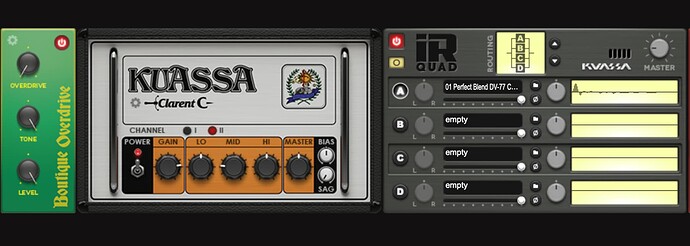This piece gets me incredibly pumped every single time! I eventually decided to transcribe it (did my best to convert the SNES chiptune sounds into Guitar and Bass parts), and recorded my own version of it (yes, the internet definitely needed one more rock cover of this  ):
):
Despite the apparent simplicity of the parts, I feel like I learned a thing or two about playing rhythm guitar in a rock/hard rock style. The bass is for the most part simple but powerful, and programming the drums was great fun (I took some liberties there - using as a starting point a Midi file by Anthony Bouchereau: http://anthony.bouchereau.free.fr/).
I want to highlight some cool things about it, and why I think (if you are a rock or metal guitar player) you owe it to yourself to learn all the parts:
The Upbeat
A lot of the tune relies on anticipating the next beat — most chord changes happen on the “And of Four” - i.e. on the upbeat. This gives an incredible forward energy and groove to the piece.
At the same time, one has to be very careful to not anticipate too much, otherwise it won’t sound groovy at all, just rushed!
The rhythm guitar riffs
I absolutely LOVE the little melodic riffs that the rhythm guitar is doing underneath the main melody. At face value it’s just a bunch of dyads (2-note chords) where the higher note moves back and forth, played in short stabs with a lot of syncopation and emphasis on the upbeats.
How hard can it be? Well, the part is not hard to learn, but it’s pretty hard to make it sound good and tight with the rest of the rhythm section. My first attempts were so out of time it physically hurt me to listen back to them 
I feel like the process of tightening these parts (simple as they seem) made me a better rhythm guitar player.
Also, it’s incredible how good it sounds to just arpeggiate a 7th chord once in a while (B section at 00:32 onwards).
The “laid back B section”
In the rare occasions when a chord suddenly lands on the “One” (downbeat), like at 00:32, you immediately get a feeling of “dramatic slowdown”, even though the tempo has remained unchanged. This is further emphasized by the drums going half time.
Note however that the second half of this section does instead start on the upbeat (00:39) — it took me a while to realise that this was happening while transcribing and playing the piece — it almost escaped me. But now I really appreciate how this subtle change gives an extra edge to the second part. We are still laying back, but we’re slowly building up that energy again and getting ready for an epic conclusion!
All in all, the laid back B section prepares us perfectly for what is coming next. Then, the C section totally delivers the goods (and more!).
The Melody
For both A and C sections, the melody starts on beat 2. This allows you to fully feel the power of the rhythm section upbeats without distraction. I am appreciating more and more how powerful it can be to have a pause in the melody where most people would expect your “main note”, if that makes sense.





 )
)
